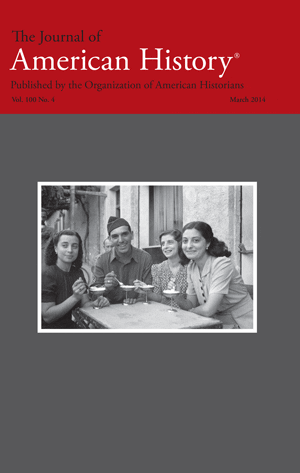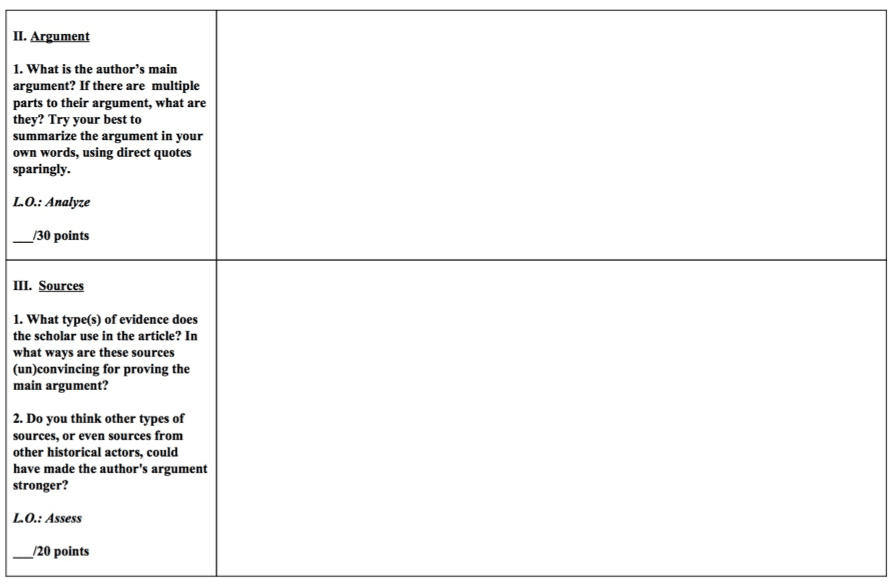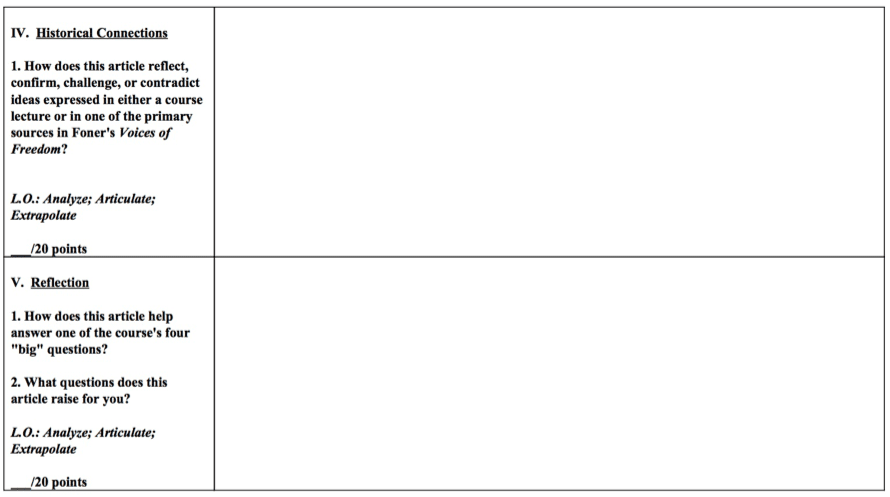[Originally posted on Process History on September 5, 2017.]
Near the end of the spring semester, my department asked me to teach a summer session of U.S. History since 1865. I had a short time to think about what I’d teach and how I’d teach it. For me, it was important for students to “do” the work of historians. This meant more than reading primary sources, though. In addition to this, students would engage with “essential questions” that are key for understanding the United States’ recent past. Moreover, in lieu of assigning a traditional textbook, which might not fully align with these essential questions, I decided that my students would read, analyze, and critique articles from the Journal of American History.
My first preparatory task was to frame the course around the essential questions. I wanted to create questions around a broad range of potential student interests. I chose four topics: 1) America’s role in the world; 2) economics and labor; 3) women and gender; and 4) comparative civil rights. These topics covered some of the important themes of post-Civil War U.S. History.
The questions I crafted (see Figure #1: The Course’s Essential Questions) were beneficial on several levels. Initially, they helped me with one of the most daunting challenges of syllabus creation—picking and choosing content to cover. These essential questions narrowed what I would focus on; lectures and in-class activities would always have to answer (at least) one of these questions. On top of this, I used the four questions to pick articles from the Journal of American History. From a content standpoint, these articles would provide additional detail that my lectures and in-class activities might not be able to cover in depth.
Selecting academic articles for an introductory survey can be tricky. I had to think about whether students would have enough prior knowledge to truly engage with the secondary source. At the same time, I needed to be cognizant of whether the article covered a fair amount of time, which might then help students understand important historical concepts, like change over time and contingency. Moreover, if I could, I wanted the articles to be useful for answering more than one of the course’s essential questions.
I ultimately chose fifteen articles from the Journal of American History to help students answer the course’s four essential questions. (See Figure #2: Academic Articles for a complete list.) Erika Lee’s “Enforcing the Borders,” for example, helped students compare and contrast a wide-range of racialized lived experiences from the Chinese Exclusion Act through the 1924 Immigration Act. Her article complemented lecture material on and primary sources about the history of white supremacy. Julia Mickenberg’s “Suffragettes and Soviets,” on the other hand, highlighted the interconnections between domestic and global events. Mickenberg’s article proved useful for students interested in women’s and gender history as well as those fascinated by the events of the First World War. Jacquelyn Dowd Hall’s classic, “The Long Civil Rights Movement,” was one of my students’ favorite articles. Hall famously critiqued the “classical” phase of the Civil Rights Movements in her article. Yet, for the purposes of my course, Hall’s article also helped students better understand the history of African Americans, the intersection of race and gender, and racialized economics. Hall’s seminal article, then, could assist students with three of the course’s four essential questions.
Students who are used to reading textbooks, however, can find reading academic articles challenging. To have them gain the skills necessary to successfully engage with these academic articles, I devoted a fair amount of in-class time to reading, interpreting, and analyzing these sources. I viewed my role as an encouraging coach who kept his approach to the analysis of academic articles straightforward and accessible. For the first three articles assigned in the class, I had students (re)read the introduction and the conclusion with a partner or in small groups. I asked students to underline and annotate where the historian(s) articulated their argument. Sometimes this meant that students had to mark several parts of the introduction and conclusion, trying to make sense of complex arguments which had multiple supporting parts. At first, this was a tough task for students, consuming upwards of 20 minutes of a 75-minute class. However, as we spent more time on this skill, students slowly gained more confidence. I was able to go around the room to work with small groups of students, focusing them on specific parts of introductions and conclusions. After a couple sessions, I asked students to paraphrase arguments in their own words. Students’ confidence grew the more they worked with one part of “doing” history—understanding historical arguments. Over time, what had taken 20 or 25 minutes soon dwindled to 12 or 15.
Students were required to write an analysis for two of the academic articles they read. To ensure further success, students were provided a fair amount of scaffolding on these assignments. To assist with article analyses, I created a reading grid that asked students to: research the historian/scholar; note and critique the sources used in the article; make historical connections to lectures and/or primary sources; and reflect on how the source could answer one of the course’s essential questions. I had detailed questions for each box of the reading grid, providing a fair amount of guidance for students to understand what they should be looking for when analyzing an article. Figure #3:The Reading Grid displays the course’s emphasis on scaffolding the analysis of academic articles.
By the end of the term, I could see that the focus on teaching with and analyzing academic articles worked on several levels. The most important, in my opinion, was how students improved from their first to their second article analysis. They had a much more nuanced understanding of historical argumentation in their second analyses. In addition, students wrote more critically about the historians’ source bases and felt more comfortable critiquing “master narratives” they had learned in high school. For those afraid of using academic articles in their surveys, I want to offer a simple reassurance: students never shied away from this hard work. My provisional course instructor survey scores indicate that students recognized article analyses as a core part of their learning. I already have a strong sense of which articles students enjoyed, but I hope my course instructor surveys include constructive criticism about the articles students viewed as least helpful for answering the course’s essential questions.
There were other outcomes to using academic articles. Many of the articles I selected emphasized U.S. History in a transnational perspective. As a result, students had to think about the United States as a place which influences—and is influenced by—others parts of the world. By carefully selecting articles, I also made it so I did not have to assign a traditional textbook. Lectures, primary sources, and the articles covered enough material for students to understand the American experience and to walk away with their own informed interpretation of the nation’s history.
As an educator now weeks removed from the course I taught, I see an even greater purpose to teaching with academic articles. As we navigate a period of deep political division, one that is fraught with fear for many, teaching with academic articles has the possibility to instill crucial civic skills in our students. By respectfully challenging those who came before them, each scholar I assigned demonstrated that disagreement is a core part of the democratic experience. Using academic articles instead of a textbook allowed my students to see that disagreement does not need to be hateful or vitriolic. Instead, it can be a productive way to move forward, pushing in the direction of the “more perfect Union” enshrined in the Constitution.
Figure 1: The Course’s Essential Questions
| America’s role in the world | Determine how the United States’ foreign policy changed and/or remained consistent from the Spanish-American War through the Cold War. How did the U.S. confront the challenges it faced around the globe? Are there core tenets (or beliefs) that have guided American foreign policy? If so, what are they? If not, how do foreign policy conflicts differ from each other? |
| Economics and labor | Evaluate the ways the American economy has changed over the past 150 years. How did “big business” alter the landscape of U.S. industry? Why did Progressive Era and New Deal reformers pass the reforms they did? Have Americans found a way to balance economic growth and workers’ rights in the post-World War II period? |
| Women and gender | Analyze the political and economic fight for women’s equality. To what extent has the role and status of women changed over the past 150 years? What have been landmark victories for women’s rights? Why have various political factions opposed women’s and feminist groups? Is there work left to be done? |
| Comparative civil rights | The continued fight for equality has, in many ways, defined the American experience. Compare and contrast the struggle for civil rights that two of the following segments of the population experienced: 1) African Americans; 2) women; 3) Mexican Americans; 4) Asian Americans; and/or 5) LGBTQ individuals. Are there commonalities that you see in the political rhetoric and tactics of these two groups? How would you describe the unique challenges these segments of the population faced? What are the arguments, agendas, challenges, etc. that have made coalitions difficult to form, both within and between different rights movements? |
| Author | Article title | Year of publication | Essential question(s) answered |
| Erika Lee | Enforcing the Borders: Chinese Exclusion along the U.S. Borders with Canada and Mexico, 1882-1924 | 2002 | America’s role in the world & comparative civil rights |
| Richard White | Information, Markets, and Corruption: Transcontinental Railroads in the Gilded Age | 2003 | Economics and labor |
| Jürgen Martschukat | “The Art of Killing by Electricity”: The Sublime and the Electric Chair | 2002 | Economics and labor & comparative civil rights |
| Julia L. Mickenberg | Suffragettes and Soviets: American Feminists and the Specter of Revolutionary Russia | 2014 | America’s role in the world; women and gender; & comparative civil rights |
| Lisa McGirr | The Passion of Sacco and Vanzetti: A Global History | 2007 | America’s role in the world; economics and labor; & comparative civil rights |
| Julia C. Ott | “The Free and Open People’s Market”: Political Ideology and Retail Brokerage at the New York Stock Exchange, 1913–1933 | 2009 | Economics and labor |
| Rachel Louise Moran | Consuming Relief: Food Stamps and the New Welfare of the New Deal | 2011 | Economics and labor & women and gender |
| James J. Weingartner | Americans, Germans, and War Crimes: Converging Narratives from “the Good War” | 2008 | America’s role in the world & comparative civil rights |
| Thomas A. Guglielmo | Fighting for Caucasian Rights: Mexicans, Mexican Americans, and the Transnational Struggle for Civil Rights in World War II Texas | 2006 | America’s role in the world; economics and labor; & comparative civil rights |
| Elaine Tyler May | Security against Democracy: The Legacy of the Cold War at Home | 2011 | America’s role in the world; economics and labor; women and gender; & comparative civil rights |
| Nancy Bernkopf Tucker | Taiwan Expendable? Nixon and Kissinger Go to China | 2005 | America’s role in the world & comparative civil rights |
| Jacquelyn Dowd Hall | The Long Civil Rights Movement and the Political Uses of the Past | 2005 | Economics and labor; women and gender; & comparative civil rights |
| Michael B. Katz et al. | The New African American Inequality | 2005 | Economics and labor & comparative civil rights |
| Kevin J. Mumford | The Trouble with Gay Rights: Race and the Politics of Sexual Orientation in Philadelphia, 1969-1982 | 2011 | Women and gender & comparative civil rights |
| Michael H. Hunt | In the Wake of September 11: The Clash of What? | 2002 | America’s role in the world |
Figure 3: The Reading Grid (PDF)





